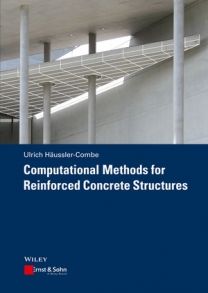Table of contents
1 FINITE ELEMENTS OVERVIEW
Modeling Basics
Discretization Outline
Elements
Material Behavior
Weak Equilibrium and Spatial Discretization
Numerical Integration and Solution Methods for Algebraic Systems
Convergence
2 UNIAXIAL STRUCTURAL CONCRETE BEHAVIOR
Scales and Short-Term Stress-Strain Behavior of Homogenized Concrete
Long-Term Behavior - Creep and Imposed Strains
Reinforcing Steel Stress-Strain Behavior
Bond between Concrete and Reinforcing Steel
The Smeared Crack Model
The Reinforced Tension Bar
Tension Stiffening of Reinforced Tension Bar
3 STRUCTURAL BEAMS AND FRAMES
Cross-Sectional Behavior
1 Kinematics - 2 Linear Elastic Behavior - 3 Cracked Reinforced Concrete Behavior - 4 Compressive Zone and Internal Forces - 5 Linear Concrete Compressive Behavior with Reinforcement - 6 Nonlinear Behavior of Concrete and Reinforcement
Equilibrium of Beams
Finite Element Types for Plane Beams
1 Basics - 2 Finite Elements for the Bernoulli Beam - 3 Finite Elements for the Timoshenko Beam - 4 System Building and Solution Methods - 5 Elementwise Integration - 6 Transformation and Assemblage - 7 Kinematic Boundary Conditions and Solution
Further Aspects of Reinforced Concrete
1 Creep - 2 Temperature and Shrinkage - 3 Tension Stiffening - 4 Shear Stiffness for Reinforced Cracked Concrete Sections
Prestressing
Large Deformations and Second-Order Analysis
Dynamics of Beams
4 STRUT-AND-TIE MODELS
Elastic Plate Solutions
Modeling
Solution Methods for Trusses
Rigid-Plastic Truss Models
More Application Aspects
5 MULTIAXIAL CONCRETE MATERIAL BEHAVIOR
Basics
1 Continua and Scales - 2 Characteristics of Concrete Behavior
Continuum Mechanics
1 Displacements and Strains - 2 Stresses and Material Laws - 3 Coordinate Transformations and Principal States
Isotropy, Linearity, and Orthotropy
1 Isotropy and Linear Elasticity - 2 Orthotropy - 3 Plane Stress and Strain
Nonlinear Material Behavior
1 Tangential Stiffness - 2 Principal Stress Space and Isotropic Strength - 3 Strength of Concrete - 4 Phenomenological Approach for the Biaxial Anisotropic Stress-Strain Behavior
Isotropic Plasticity
1 A Framework for Multiaxial Elastoplasticity - 2 Pressure-Dependent Yield Functions
Isotropic Damage
Multiaxial Crack Modeling
1 Basic Concepts of Crack Modeling - 2 Multiaxial Smeared Crack Model
The Microplane Model
Localization and Regularization
1 Mesh Dependency - 2 Regularization - 3 Gradient Damage
General Requirements for Material Laws
6 PLATES
Lower Bound Limit Analysis
1 The General Approach - 2 Reinforced Concrete Contributions - 3 A Design Approach
Crack Modeling
Linear Stress-Strain Relations with Cracking
2D Modeling of Reinforcement and Bond
Embedded Reinforcement
7 SLABS
A Placement
Cross-Sectional Behavior
1 Kinematic and Kinetic Basics - 2 Linear Elastic Behavior - 3 Reinforced Cracked Sections
Equilibrium of Slabs
1 Strong Equilibrium - 2 Weak Equilibrium - 3 Decoupling
Structural Slab Elements
1 Area Coordinates - 2 A Triangular Kirchhoff Slab Element
System Building and Solution Methods
Lower Bound Limit Analysis
1 General Approach and Principal Moments - 2 Design Approach for Bending - 3 Design
Approach for Shear
Kirchhof Slabs with Nonlinear Material Behavior
8 SHELLS
Approximation of Geometry and Displacements
Approximation of Deformations
Shell Stresses and Material Laws
System Building
Slabs and Beams as a Special Case
Locking
Reinforced Concrete Shells
1 The Layer Model - 2 Slabs as Special Case - 3 The Plastic Approach
9 RANDOMNESS AND RELIABILITY
Basics of Uncertainty and Randomness
Failure Probability
Design and Safety Factors
10 APPENDICES
A Solution of Nonlinear Algebraic Equation Systems
B Crack Width Estimation
C Transformations of Coordinate Systems
D Regression Analysis
E Reliability with Multivariate Random Variables
F Programs and Example Data



